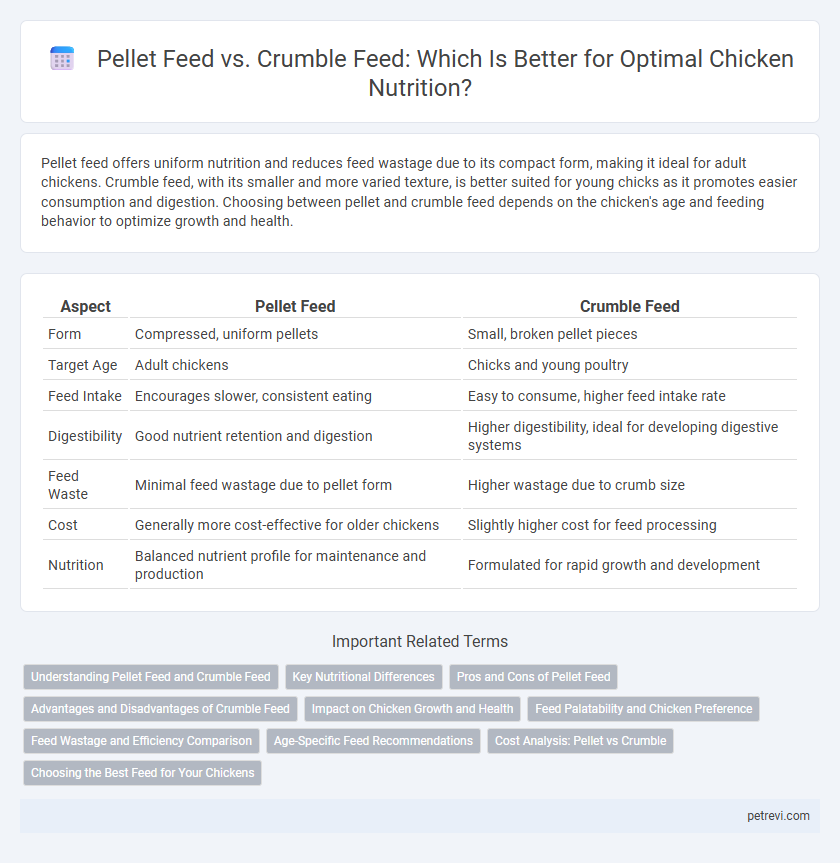Pellet feed offers uniform nutrition and reduces feed wastage due to its compact form, making it ideal for adult chickens. Crumble feed, with its smaller and more varied texture, is better suited for young chicks as it promotes easier consumption and digestion. Choosing between pellet and crumble feed depends on the chicken's age and feeding behavior to optimize growth and health.
Table of Comparison
| Aspect | Pellet Feed | Crumble Feed |
|---|---|---|
| Form | Compressed, uniform pellets | Small, broken pellet pieces |
| Target Age | Adult chickens | Chicks and young poultry |
| Feed Intake | Encourages slower, consistent eating | Easy to consume, higher feed intake rate |
| Digestibility | Good nutrient retention and digestion | Higher digestibility, ideal for developing digestive systems |
| Feed Waste | Minimal feed wastage due to pellet form | Higher wastage due to crumb size |
| Cost | Generally more cost-effective for older chickens | Slightly higher cost for feed processing |
| Nutrition | Balanced nutrient profile for maintenance and production | Formulated for rapid growth and development |
Understanding Pellet Feed and Crumble Feed
Pellet feed consists of compressed, uniform-sized particles that offer consistent nutrient distribution and reduce feed wastage in chicken nutrition. Crumble feed is produced by breaking pellets into smaller pieces, making it easier for young chicks to consume and digest. Both feed types enhance growth performance but differ in texture and suitability depending on the chicken's age and feeding behavior.
Key Nutritional Differences
Pellet feed offers uniform nutrient distribution, promoting consistent intake of proteins, vitamins, and minerals essential for optimal chicken growth, while crumble feed provides smaller, bite-sized particles that improve digestibility and reduce feed wastage in younger chickens. Pellets typically have a higher density of energy and protein, supporting stronger weight gain and feed conversion ratios compared to crumbles. Crumble feed is often preferred during early developmental stages due to its ease of consumption, enhancing nutrient absorption and overall flock health.
Pros and Cons of Pellet Feed
Pellet feed offers efficient nutrition delivery with minimal waste, promoting better feed conversion ratios and uniform growth in chickens. However, the manufacturing process can reduce some vitamin stability, and pellets may be less palatable for young chicks, potentially leading to reduced initial feed intake. Despite these drawbacks, pellet feed remains a popular choice for mature chickens due to ease of handling and storage, along with consistent nutrient composition.
Advantages and Disadvantages of Crumble Feed
Crumble feed offers enhanced digestibility and reduced feed wastage for chickens by providing smaller, uniform particles that are easier to consume, particularly for young chicks. Its disadvantages include higher susceptibility to moisture absorption, which can lead to mold growth and spoilage, and lower durability during transportation compared to pellet feed. This form of feed supports improved growth rates but requires careful storage and handling to maintain nutritional quality.
Impact on Chicken Growth and Health
Pellet feed enhances chicken growth by providing uniform nutrition and reducing feed wastage, promoting optimal weight gain and feed conversion efficiency. Crumble feed improves digestibility and reduces feed sorting, supporting gut health and nutrient absorption vital for disease resistance and overall vitality. Choosing the appropriate feed form directly influences growth rate, immune function, and production performance in poultry farming.
Feed Palatability and Chicken Preference
Pellet feed generally enhances feed palatability due to its uniform size and density, promoting easier handling and reduced wastage, which aligns with chickens' natural pecking instincts, resulting in higher consumption rates. Crumble feed offers finer texture and increased surface area, stimulating chickens' gustatory receptors and supporting selective feeding behaviors, especially in young or smaller birds. Studies reveal chickens show a preference for pellet feed in terms of intake efficiency, while crumble feed supports better nutrient absorption due to its breakdown during ingestion.
Feed Wastage and Efficiency Comparison
Pellet feed for chickens offers higher nutrient density and reduced wastage compared to crumble feed, as pellets minimize dust and selective feeding behaviors. Crumble feed tends to increase feed wastage due to particle segregation and spillage, impacting overall feed efficiency negatively. Studies show pellet feed improves feed conversion ratio (FCR) by up to 10%, enhancing growth performance while reducing feeding costs in poultry production.
Age-Specific Feed Recommendations
Pellet feed offers uniform nutrition and reduced feed wastage, making it ideal for adult chickens with stronger beaks, while crumble feed is better suited for young chicks due to its smaller, easily digestible particles. Nutrient density in crumble feed supports rapid growth during the early stages, whereas pellet feed helps maintain optimal health and productivity in mature birds. Age-specific formulation ensures balanced protein, vitamins, and minerals tailored to the developmental needs of chickens at each life stage.
Cost Analysis: Pellet vs Crumble
Pellet feed typically costs more to produce due to the energy-intensive pelleting process and machinery maintenance compared to crumble feed, which involves simpler grinding and conditioning steps. While pellet feed reduces feed wastage by minimizing fines and dust, crumbles offer better cost-efficiency for small-scale or starter broilers with lower feed intake. Poultry producers must balance feed conversion ratios and upfront costs, as pellet feed often improves growth rates but at a higher initial expense than crumble feed.
Choosing the Best Feed for Your Chickens
Pellet feed offers uniform nutrient distribution and reduces feed wastage, promoting consistent growth and improved feed conversion ratio in chickens. Crumble feed is ideal for younger chicks due to its smaller particle size, enhancing digestibility and feed intake during early development stages. Selecting the best feed depends on the age of the chickens, with crumble feed suited for chicks and pellet feed for mature birds to optimize nutrition and overall health.
Pellet Feed vs Crumble Feed for Chicken Nutrition Infographic

 petrevi.com
petrevi.com